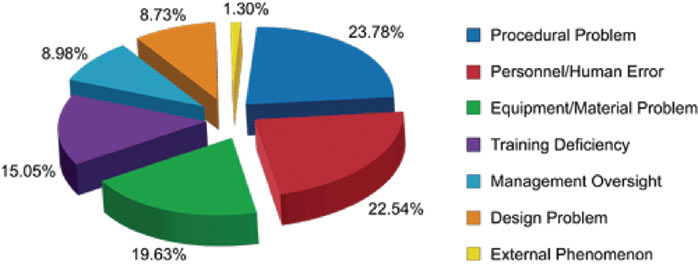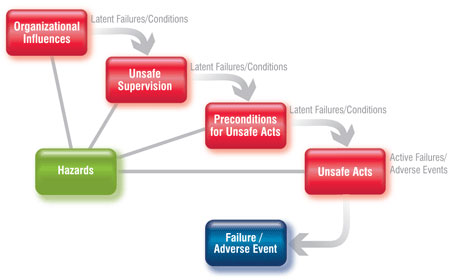Human Factors Engineering: The Next Frontier in Reliability
Over the 20 years that I’ve been in the reliability engineering field, most of our effort to improve the dependability of manufacturing processes has been equipment focused. I’ve been no exception. On the surface, it seems to make sense. It’s the equipment that breaks down, isn’t it? Yes and no.
A few years ago, I asked our readers to tell me what goes wrong in the factory based upon the general failure cause categories outline in the U.S. Department of Energy’s root cause analysis standard (DOE-NE-1004-92). You replied that the equipment is to blame in less than 20 percent of the occurrences. Nearly 80 percent of what goes wrong can be attributed to people issues. Problems with procedures and training (combined) are responsible for nearly 40 percent. Personnel/human error constituted a little more than 22 percent of the vote. Management oversight represented about 9 percent. Also, design problems totaled roughly 9 percent.
Really, though, wouldn’t you agree that if we had good procedures, training and supervision that we’d go a long way toward minimizing personnel/human error? The bottom line is that human factors are responsible for 75 to 80 percent of what goes wrong in the factory. It’s time for us to align our efforts accordingly.

Analysis and Classification
In 2003, the U.S. Secretary of Defense proclaimed in a memorandum that “world-class organizations do not tolerate preventable accidents.” This led to an edict to reduce preventable errors by 50 percent and resulted in the formation of the Department of Defense Safety and Oversight Committee and the relatively new branch of reliability management called Human Factors Engineering (HFE). The intent was to develop and standardize a human performance coding, analysis and management system throughout the DoD; it is called the Human Factors Analysis and Classification System (HFACS). While it was developed to improve aviation safety, it is fully applicable to any reliability-critical application or industry (including manufacturing) where people are highly integrated in the business processes.
DoD statistics suggest that human error is a causal factor in 80 to 90 percent of all mishaps. As previously discussed, my research into the manufacturing industries similarly suggests that human error accounts for around 80 percent of what goes wrong in plants and factories. Since human error is the dominant failure mechanism in most systems (healthcare being no exception), it should be the focal point of our reliability management system.
The human factors classification system is broadly organized into the three latent failure and one active failure categories.
-
Organization Influences (Latent Failures/Conditions): This category includes the failure to provide adequate resources, an appropriate organizational climate and/or sufficient organizational processes, such as procedures.
-
Unsafe Supervision (Latent Failures/Conditions): This category includes inadequate supervision, planned operations that are known to be inappropriate, failure to correct known problems and violations made by supervisors.
-
Preconditions for Unsafe Acts (Latent Failures/Conditions): These include:
-
environmental factors, such as the physical and technological environment;
-
condition of the individuals, including cognitive and psycho-behavioral factors;
-
condition of the individuals, including physiological state, physical/mental limitations and perceptual errors; and,
-
personnel factors, including coordination, communication and planning errors, and self-imposed stress such as fitness, alcohol/drug use, nutrition, etc.
-
-
Unsafe Acts (Active Failures/Adverse Events): These include errors caused by lack of skill and/or clear instruction, errors in judgment, and errors in perceptions. They also include violations.
Applicable to Manufacturing
 The human error coding and management system developed by the DoD is quite comprehensive. In total, they’ve identified 131 latent and 16 active errors that lead to a failure or adverse event. Likewise, because the failure classification system includes latent and active failures, it is fully applicable to the classification of near-misses as well as actual failure events. By and large, the management system can be adopted in its entirety for use in the manufacturing sector. There are a few that don’t apply and probably a few that are missing, but with minor revisions, the DoD-HFACS can and should be immediately employed to analyze and prevent human error in facilities.
The human error coding and management system developed by the DoD is quite comprehensive. In total, they’ve identified 131 latent and 16 active errors that lead to a failure or adverse event. Likewise, because the failure classification system includes latent and active failures, it is fully applicable to the classification of near-misses as well as actual failure events. By and large, the management system can be adopted in its entirety for use in the manufacturing sector. There are a few that don’t apply and probably a few that are missing, but with minor revisions, the DoD-HFACS can and should be immediately employed to analyze and prevent human error in facilities.
The Need to Execute
Kurt Vonnegut said in one of his novels “if it weren’t for the people ... always getting tangled up with the machinery; if it weren’t for them, Earth would be an engineer’s paradise.” The bottom line is that people are – and in all likelihood will always be – in the mix. Since that’s where most of our problems occur, we’d better get busy to start mitigating human factors risks. To do so, our Failure Reporting, Analysis and Corrective Action System (FRACAS) must contain a Human Factors Analysis and Classification System (HFACS).
The DoD has done the heavy lifting by creating this system. We simply need to execute. If you don’t have a FRACAS for collecting failure data, call or e-mail me. You can’t manage reliability without it. Remember my axiom for reliability management: Data is the difference between deciding and guessing!
